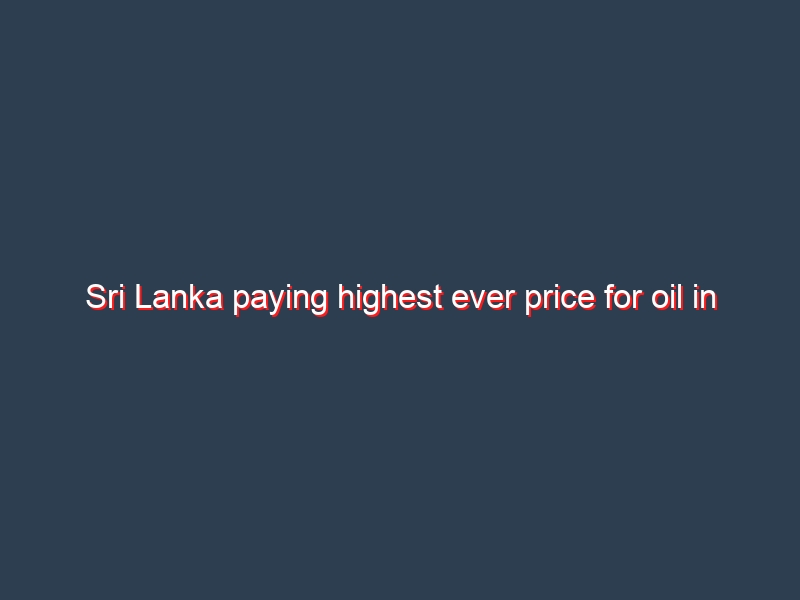ECONOMYNEXT – Sri Lanka is currently facing its highest ever crude oil price in the local currency because of a steep depreciation in the rupee, Energy Minister Udaya Gammanpila said, though global prices are below the level when the Fed’s housing bubble collapsed in 2008.
The global crude oil price was at 95 US dollars per barrel as of February 16 in the current bubble fired by Fed Chief Jerome Powell, much lower than the record price of 147 US dollars fetched in May 2008 amid the Bernanke-Greenspan bubble which collapsed shortly after.
However, Minister Gammanpila said Sri Lanka is already facing its historically highest price.
“When the global crude price was at 147 US dollar per barrel in 2008, our rupee was 108 per dollar. So we paid only 15,876 rupees per barrel of crude at that time,” he told a media briefing on Friday (18).”
“However, now the rupee is 203 rupees and the crude price is 95 US dollar per barrel. As a result, now we have to pay 19,285 rupees. This is the highest ever price.”
Sri Lanka rupee has collapsed in a series of currency crises in 2012 (to 131), 2015/2016 (to 151), 2018 (182) as the central bank printed money to control short term interest rates and ‘stimulate’ the economy.
The rupee is facing downward pressure in the latest currency crisis, which is still ongoing. The rupee has is now around 202 to the US dollar and parallel exchange rates are around 248 rupees.
Countries with untamed central banks like Pakistan and Sri Lanka face ever depreciating currencies, ever rising fuel and electricity prices, as well as ever rising debt, when the ruling class tries to deceive the public by not market pricing energy to reflect global prices and central bank depreciation.
So-called ‘circular debt also expands between the petroleum utility and the power utility and between the power utility and independent power producers (IPPs) as the currency is depreciated from money printing and prices are controlled.
Sri Lanka and Pakistan central banks have also among the highest reported inflation in Asia.
In sharp contrast Singapore has now started to appreciate its currency to ward off inflation generated by the Federal Reserve and European Central Bank which was misled by modern monetary theory and Keynesian ‘stimulus’ dogma.
In 2008 June, when Brent crude hit 138 US dollars a barrel, it was worth 181 Singapore dollars and 14,261 Sri Lanka central bank rupees.
By January 2022, when a Brent crude barrel hit 83 dollars, it is measured in 135 Monetary Authority of Singapore dollars.
In Central Bank of Sri Lanka rupees the same Brent barrel has to be bought at 17,000.
Singapore resisted setting up a money printing central bank based on Anglo-US stimulus dogma.
Sri Lanka is now in serious economic trouble with looming sovereign default after printing money (expanding central bank credit) to create a ‘production economy’.
“The way to a better life was through hard work, first in schools, then in universities or polytechnics and then on the job in the work place,” Singapore’s first Finance Minister Goh Keng Swee has said.
“Diligence, education and skills will create wealth, not Central Bank credit.
“There was no effective way of exchange control in an open trading economy like ours to deal with the inevitable balance of payments troubles.
“Hence, we were not impressed by claims — excessive as they turned out to be — that government could bring about prosperity through spending. It did not surprise us that the Anglo-Saxon countries which adopted such policies got into trouble.
“We also noted that the Germans and Japanese did not believe they could “spend their way to prosperity”, as the phrase went. Like Singaporeans, they set store on diligence, education and skills.”
Keynesian dogma became fashionable especially after the Federal Reserve printed money and created the Great Depression.
Such teachings, a regurgitation of Mercantilist teachings of John Law among others, became the standard dogma is many UK and US universities going against 200 years of classical economic theory.
“When nearly two-thirds of our citizens’ expenditure is spent on imported goods, a strong Singapore Dollar helps to keep consumer prices down,” Goh said.
“…[W]e wanted to indicated to academics, both local and foreign; that what is fashionable in the West is not necessarily good for Singapore. A perceptive mind is needed to distinguish the peripheral form the fundamental, transient fads from permanent values.”
”…[I]n poor countries, punishment comes quickly in a cruel way — high rates of inflation, economic decline and political instability. These three factors reinforce each other in a way which makes escape from misery difficult. (Colombo/Feb20/2022)

